Much has been learned about Saturn’s system of moons in recent decades, thanks to the Voyager missions and the more recent surveys conducted by the Cassini spaceprobe. Between its estimated 150 moons and moonlets (only 53 of which have been identified and named) there is no shortage of scientific curiosities, and enough mysteries to keep astronomers here on Earth busy for decades.
Consider Mimas, which is often referred to as Saturn’s “Death Star Moon” on a count of its unusual appearance. Much like Saturn’s moons Tethys and Rhea, Mimas’ peculiar characteristics represents something of a mystery. Not only is it almost entirely composed ice, it’s coloration and surface features reveal a great deal about the history of the Saturnian (aka. Cronian) system. On top of that, it may even house an interior, liquid-water ocean.
Discovery and Naming:
Saturn’s moon Mimas was discovered by William Herschel in 1789, more than 100 years after Saturn’s larger moons were discovered by Christian Huygens and Giovanni Cassini. As with all the seven then-known satellites of Saturn, Mimas’ name was suggested by William Herschel’s son John in his 1847 publication Results of Astronomical Observations made at the Cape of Good Hope.
Mimas takes its name from one of the Titans of Greek mythology, who were the sons and daughters of Cronus (the Greek equivalent to Jupiter). Mimas was an offspring of Gaia, born from the blood of the castrated Uranus, who eventually died during the struggle with the Olympian Gods for control of the universe.
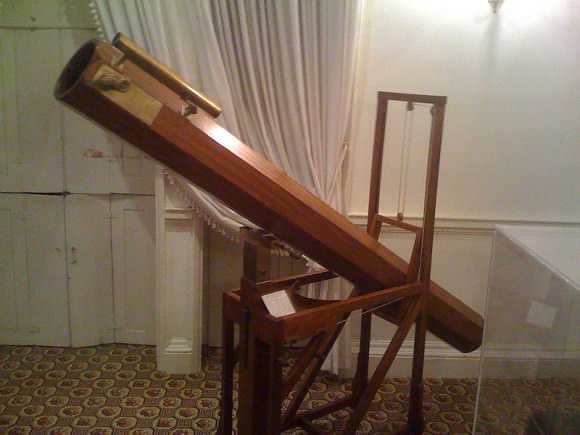
Size, Mass and Orbit:
With a mean radius of 198.2 ± 0.4 km and a mass of about 3.75 ×1019 kg, Mimas is equivalent in size to 0.0311 Earths and 0.0000063 times as massive. Orbiting Saturn at an average distance (semi-major axis) of 185,539 km, it is the innermost of Saturn’s larger moons, and the 8th moon orbiting Saturn. It’s orbit also has a minor eccentricity of 0.0196, ranging from 181,902 km at periapsis and 189,176 km at apoapsis.
With an estimated orbital velocity of 14.28 km/s, Mimas takes 0.942 days to complete a single orbit of Saturn. Like many of Saturn’s moons. Mimas rotation period is synchronous to its orbital period, which means it keeps one face constantly pointing towards the planet. Mimas is also in a 2:1 mean-motion resonance with the larger moon Tethys, and in a 2:3 resonance with the outer F Ring shepherd moonlet, Pandora.
Composition and Surface Features:
Mimas’ mean density of 1.1479 ± 0.007 g/cm³ is just slightly higher than that of water (1 g/cm³), which means that Mimas is mostly composed of water ice, with just a small amount of silicate rock. In this respect, Mimas is much like Tethys, Rhea, and Dione – moon’s of Saturn that are primarily composed of water ice.
Due to the tidal forces acting on it, Mimas is noticeably prolate – i.e. its longest axis is about 10% longer than the shortest, giving it its egg-shaped appearance. In fact, with a diameter of 396 km (246 mi), Mimas is just barely large and massive enough to achieve hydrostatic equilibrium (i.e. to become rounded in shape under the force of its own gravitation). Mimas is the smallest known astronomical body to have achieved this.
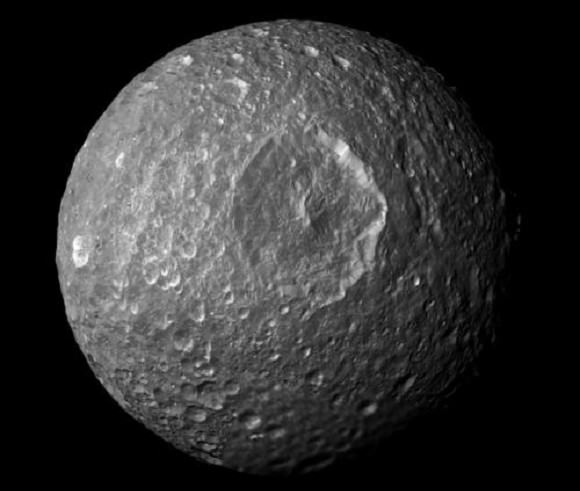
Three types of geological features are officially recognized on Mimas: craters, chasmata (chasms) and catenae (crater chains). Of these, craters are the most common, and it is believed that many of them have existed since the beginning of the Solar System. Mimas surface is saturated with craters, with every part of the surface showing visible depressions, and newer impacts overwriting older ones.
Mimas’ most distinctive feature is the giant impact crater Herschel, named in honor of William Herschel (the discoverer of Uranus, its moons Oberon, and Titania, and the Cronian moons Enceladus and Mimas). This large crater gives Mimas the appearance of the “Death Star” from Star Wars. At 130 km (81 mi) in diameter, Herschel’s is almost a third of Mimas’ own diameter.
Its walls are approximately 5 km (3.1 mi) high, parts of its floor measure 10 km (6.2 mi) deep, and its central peak rises 6 km (3.7 mi) above the crater floor. If there were a crater of an equivalent scale on Earth, it would be over 4,000 km (2,500 mi) in diameter, which would make it wider than the continent of Australia.
The impact that made this crater must have nearly shattered Mimas, and is believed to have created the fractures on the opposite side of the moon by sending shock waves through Mimas’s body. In this respect, Mimas’ surface closely resembles that of Tethys, with its massive Odysseus crater on its western hemisphere and the concentric Ithaca chasma, which is believed to have formed as a result of the impact that created Odysseus.
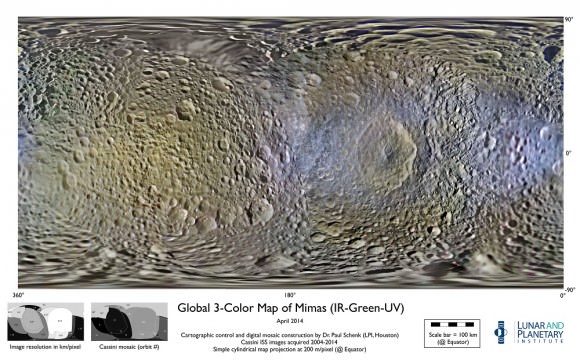
Mimas’ surface is also saturated with smaller impact craters, but no others are anywhere near the size of Herschel. The cratering is also not uniform, with most of the surface being covered with craters larger than 40 km (25 mi) in diameter. However, in the south polar region, there are generally no craters larger than 20 km (12 mi) in diameter.
Data obtained in 2014 from the Cassini spacecraft has also led to speculation about a possible interior ocean. Due to the planet’s libration (oscillation in its orbit), scientists believe that the planet’s interior is not uniform, which could be the result of a rocky interior or an interior ocean at the core-mantle boundary. This ocean would likely be maintained thanks to tidal flexing caused by Mimas’ orbital resonances with Tethys and Pandora.
A number of features in Saturn’s rings are also related to resonances with Mimas. Mimas is responsible for clearing the material from the Cassini Division, which is the gap between Saturn’s two widest rings – the A Ring and B Ring. The repeated pulls by Mimas on the Cassini Division particles, always in the same direction, forces them into new orbits outside the gap.
Particles in the Huygens Gap at the inner edge of the Cassini division are in a 2:1 resonance with Mimas. In other words, they orbit Saturn twice for each orbit competed by Mimas. The boundary between the C and B ring is meanwhile in a 3:1 resonance with Mimas; and recently, the G Ring was found to be in a 7:6 co-rotation eccentricity resonance with Mimas.
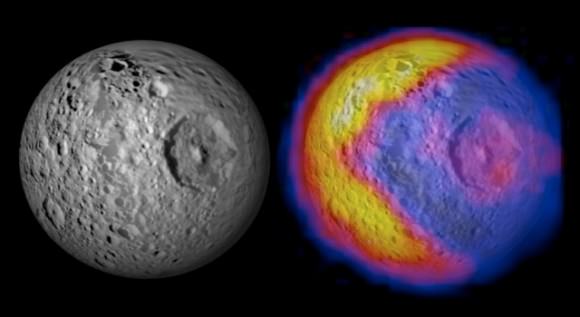
Exploration:
The first mission to study Mimas up close was Pioneer 11, which flew by Saturn in 1979 and made its closest approach on Sept. 1st, 1979, at a distance of 104,263 km. The Voyager 1 and 2 missions both flew by Mimas in 1980 and 1981, respectively, and snapped pictures of Saturn’s atmosphere, its rings, its system of moons. Images taken by Voyager 1 probe were the first ever of the Herschel crater.
Mimas has been imaged several times by the Cassini orbiter, which entered into orbit around Saturn in 2004. A close flyby occurred on February 13, 2010, when Cassini passed Mimas at a distance of 9,500 km (5,900 mi). In addition to providing multiple images of Mimas’ cratered surface, it also took measurements of Mimas’ orbit, which led to speculation about a possible interior ocean.
The Saturn system is truly a wonder. So many moons, so many mysteries, and so many chances to learn about the formation of the Solar System and how it came to be. One can only hope that future missions are able to probe some of the deeper ones, like what might be lurking beneath Mimas’ icy, imposing “Death Star” surface!
We’ve written many great articles about Mimas and Saturn’s moons here at Universe Today. Here’s one about the Herschel Crater, one about the first detailed look Cassini made, and one about it’s “Death Star” appearance.
Another great resource about Mimas is Solar Views, and you can get even more info from the Nine Planets.
We have recorded two episodes of Astronomy Cast just about Saturn. The first is Episode 59: Saturn, and the second is Episode 61: Saturn’s Moons.

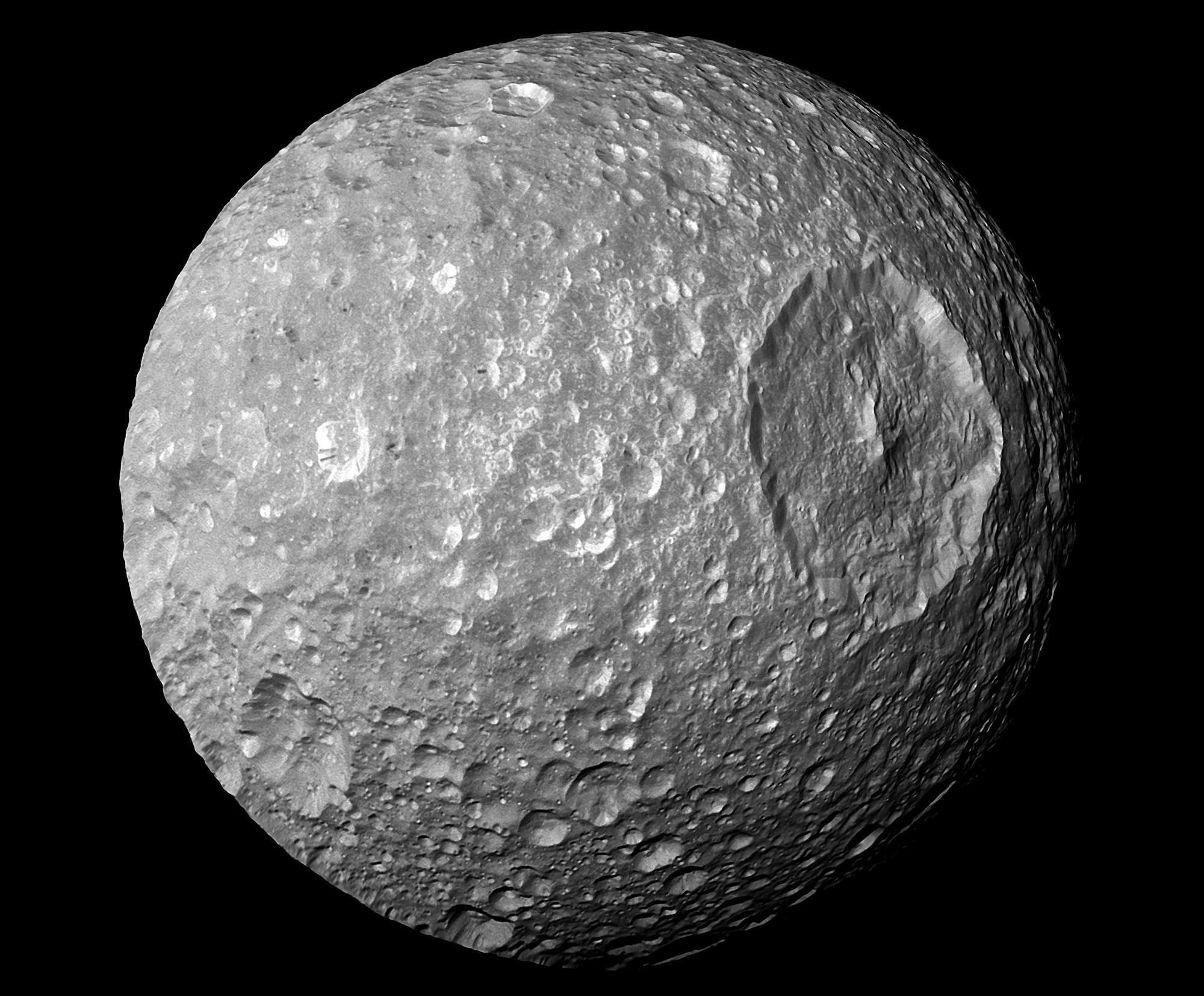
Hi Matt! As usual, you have done an excellent job. It’s refreshing to read your columns; as a NASA/JPL Solar SystemAmbassador, I am often called on to discuss a particular solar system object and your writing supplies just the right amount of facts and info. I’ve started to assemble a folder with your columns, so when some bright eight grader asks “What about the ‘Death Star’ moon?”, I am ready to go! Keep up the good work….
That’s awesome Bryan! Glad I could help and hope to be of continued service 🙂
Question: what exactly is a Solar System Ambassador and what does one do?